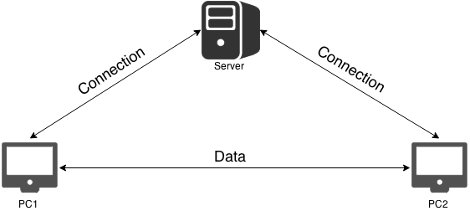WebRTC is an API that provides native plugin-free support for microphones, web cameras and data streams through a P2P connection between two clients. Two most popular web browsers, Google Chrome and Mozilla Firefox, support most of WebRTC features. WebRTC is still under development, the drafts of the standard have been published by W3C.
The initial release was announced and made open source by Google in 2011. W3C and IETF started developing the standards. As of today, there are two drafts thereof published on GitHub. The first part is about real-time communication between browsers, and second draft is about media capture and streams. Nowadays WebRTC is widely supported by different applications such as Google Chrome, Mozilla Firefox, inluding the mobile versions. There are a plenty of libraries and applications that provide easy methods for using WebRTC. Because it is still under development, current support of applications is not final and could change in the future. Most of the current features of WebRTC are ready for use and won't change too much. At least, for users there is nothing to worry about.
To secure WebRTC connection between peers, the data needs to be encrypted with DTLS. DTLS is a transport layer protocol that uses TLS to encrypt data, securing the data transfers. It also protects the data from being read on the server side. So, while the server establishes connection between users, it still cannot access their private information. WebRTC specifies DTLS use as mandatory. The benefits of WebRTC are as follows:
DeskRoll uses WebRTC to provide faster data rate between users without any additional plugins. Everything that user needs to do is use the latest version of Mozilla Firefox, Google Chrome (recommended), Opera (Blink-based). Let us see how DeskRoll leverages the benefits of WebRTC in a bit more detail. There are two different ways to send data from one device to another:


So, which implementation is better? Obviously, the second option is preferrable, so we would recommend using a web browser which supports WebRTC.
As WebRTC is a new technolgy, and it is still under development, it will take some time until it is ubiquitous. The current status of WebRTC is a "non-stable version" and further updates may create some inconveniences for developers. Of course, WebRTC may sometimes fail to provide the same stability and functions as similar implementations in native desktop application. However, it's no doubt the future of the web.
Some parts of WebRTC are already used by major vendors. For example, Microsoft announced that Skype will support WebRTC. In November 2014 company announced web version of its service. It's available only by invinations. Some sources reported that it's still needed a plugin download, so it shows that companies can't use WebRTC in productins because standart is not final.
Then, it's Deskroll of course. Albeit, it relies upon its time-tested technologies (still used in SkyFex) where WebRTC may fail.
Then, of course, the main purpose of WebRTC is to provide plugin-free support for video&audio calls. That is why many WebRTC-based solutions used in commercial products are from this niche.